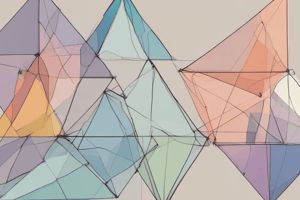Podcast
Questions and Answers
What is the sum of the interior angles of a quadrilateral?
What is the sum of the interior angles of a quadrilateral?
- 720°
- 360° (correct)
- 540°
- 180°
Which of the following describes a regular polygon?
Which of the following describes a regular polygon?
- All sides and angles are congruent (correct)
- All angles are congruent
- All sides are congruent
- No sides are congruent
What is the measure of each exterior angle of a regular pentagon?
What is the measure of each exterior angle of a regular pentagon?
- 90°
- 108°
- 60°
- 72° (correct)
Which of the following properties is true for all parallelograms?
Which of the following properties is true for all parallelograms?
Which of the following statements about diagonals in a parallelogram is true?
Which of the following statements about diagonals in a parallelogram is true?
What is the formula to find the sum of the interior angles of a polygon with n sides?
What is the formula to find the sum of the interior angles of a polygon with n sides?
Which of the following describes consecutive angles in a parallelogram?
Which of the following describes consecutive angles in a parallelogram?
What type of polygon is formed by connecting the midpoints of a quadrilateral's sides?
What type of polygon is formed by connecting the midpoints of a quadrilateral's sides?
What distinguishes a rhombus from a rectangle?
What distinguishes a rhombus from a rectangle?
Which statement is true about the diagonals of a rectangle?
Which statement is true about the diagonals of a rectangle?
Which of the following correctly characterizes a trapezoid?
Which of the following correctly characterizes a trapezoid?
In an isosceles trapezoid, which property holds true?
In an isosceles trapezoid, which property holds true?
What is true regarding kites?
What is true regarding kites?
How is the midsegment of a trapezoid defined?
How is the midsegment of a trapezoid defined?
Which property is true about the angles in an isosceles trapezoid?
Which property is true about the angles in an isosceles trapezoid?
What is a characteristic of a square?
What is a characteristic of a square?
Flashcards are hidden until you start studying
Study Notes
Polygons
- A polygon is a closed figure consisting of straight segments.
- A diagonal is a segment that joins nonconsecutive vertices of a polygon.
- The sum of the interior angles of a polygon with n sides is (n-2)180°.
- The sum of the angles of a triangle is 180°.
- An equilateral polygon has all sides congruent.
- An equiangular polygon has all angles congruent.
- A regular polygon has all sides and all angles congruent.
- The sum of the measures of exterior angles of a convex polygon is 360°.
Parallelograms
- A parallelogram is a quadrilateral with opposite sides parallel.
- Opposite sides of a parallelogram are congruent.
- Opposite angles of a parallelogram are congruent.
- Consecutive angles in a parallelogram are supplementary.
- The diagonals of a parallelogram bisect each other.
Proving Parallelograms
- If both pairs of opposite sides of a quadrilateral are congruent, then the quadrilateral is a parallelogram.
- If both pairs of opposite angles of a quadrilateral are congruent, then the quadrilateral is a parallelogram.
- If one pair of opposite sides of a quadrilateral are both parallel and congruent, then the quadrilateral is a parallelogram.
- If the diagonals of a quadrilateral bisect each other, then the quadrilateral is a parallelogram.
Special Parallelograms
- A rhombus is a parallelogram with four congruent sides.
- A rectangle is a parallelogram with four right angles.
- A square is both a rhombus and a rectangle.
- The diagonals of a rhombus are perpendicular bisectors to each other.
- The diagonals of a rhombus bisect the opposite angles.
- The diagonals of a rectangle are congruent.
Trapezoids and Kites
- A trapezoid is a quadrilateral with exactly one pair of parallel sides.
- The parallel sides in a trapezoid are called the bases.
- The non-parallel sides in a trapezoid are called the legs.
- An isosceles trapezoid is a trapezoid with congruent legs.
- Base angles of an isosceles trapezoid are congruent.
- The diagonals of an isosceles trapezoid are congruent.
- The midsegment of a trapezoid connects the midpoints of each leg. It is parallel to the bases and its length is the average of the lengths of the bases.
- A kite is a quadrilateral with two pairs of consecutive congruent sides.
- The diagonals of a kite are perpendicular.
- One pair of opposite angles in a kite is congruent.
Hierarchy of Quadrilaterals
- All squares are rectangles.
- All rectangles are parallelograms.
- All rhombuses are parallelograms.
- All parallelograms are quadrilaterals.
- All kites are quadrilaterals.
- All trapezoids are quadrilaterals.
Studying That Suits You
Use AI to generate personalized quizzes and flashcards to suit your learning preferences.




